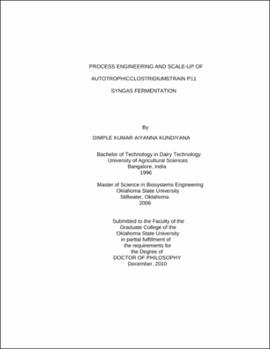| dc.contributor.advisor | Wilkins, Mark R. | |
| dc.contributor.author | Kundiyana, Dimple Kumar Aiyanna | |
| dc.date.accessioned | 2013-11-26T07:43:15Z | |
| dc.date.available | 2013-11-26T07:43:15Z | |
| dc.date.issued | 2010-12 | |
| dc.identifier.uri | https://hdl.handle.net/11244/6415 | |
| dc.description.abstract | Scope and Method of Study: Biomass gasification followed by fermentation of syngas to ethanol is a potential process to produce bioenergy. The process is currently being researched under laboratory- and pilot-scale in an effort to optimize the process conditions and make the process feasible for commercial production of ethanol and other biofuels such as butanol and propanol. The broad research objectives for the research were to improve ethanol yields during syngas fermentation and to design a economical fermentation process. The research included four statistically designed experimental studies in serum bottles, bench-scale and pilot-scale fermentors to screen alternate fermentation media components, to determine the effect of process parameters such as pH, temperature and buffer on syngas fermentation, to determine the effect of key limiting nutrients of the acetyl-CoA pathway in a continuous series reactor design, and to scale-up the syngas fermentation in a 100-L pilot scale fermentor. | |
| dc.description.abstract | Findings and Conclusions: The first experimental study identified cotton seed extract (CSE) as a feasible medium for Clostridium strain P11 fermentation. The study showed that CSE at 0.5 g L-1 can potentially replace all the standard Clostridium strain P11 fermentation media components while using a media buffer did not significantly improve the ethanol production when used in fermentation with CSE. Scale-up of the CSE fermentation in 2- L and 5-L stirred tank fermentors showed 25% increase in ethanol yield. The second experimental study showed that syngas fermentation at 32 degrees C without buffer was associated with higher ethanol concentration and reduced lag time in switching to solventogenesis. Conducting fermentation at 40 degrees C or by lowering incubation pH to 5.0 resulted in reduced cell growth and no production of ethanol or acetic acid. The third experiment studied the effect of three limiting nutrients, calcium pantothenate, vitamin B12 and CoCl2 on syngas fermentation. Results indicated that it is possible to modulate the product formation by limiting key nutrients of acetyl-CoA pathway and using a continuous fermentation in two-stage fermentor design to improve ethanol yields. The last experimental study was conducted to commission a pilot scale fermentor, and subsequently scale-up the Clostridium strain P11 fermentation from a bench-scale to a pilot scale 100-L fermentor. Results indicated a six-fold improvement in ethanol concentration (25.3 g L-1 at the end of 59 d) compared to previous Clostridium strain P11 and Clostridium carboxidivorans fermentations plus the formation of other compounds such as isopropyl alcohol, acetic acid and butanol, which are of commercial importance. | |
| dc.format | application/pdf | |
| dc.language | en_US | |
| dc.rights | Copyright is held by the author who has granted the Oklahoma State University Library the non-exclusive right to share this material in its institutional repository. Contact Digital Library Services at lib-dls@okstate.edu or 405-744-9161 for the permission policy on the use, reproduction or distribution of this material. | |
| dc.title | Process engineering and scale-up of autotrophic Clostridium strain P11 syngas fermentation | |
| dc.contributor.committeeMember | Bellmer, Danielle D. | |
| dc.contributor.committeeMember | McGlynn, William | |
| dc.contributor.committeeMember | Huhnke, Raymond L. | |
| osu.filename | Kundiyana_okstate_0664D_11098.pdf | |
| osu.accesstype | Open Access | |
| dc.type.genre | Dissertation | |
| dc.type.material | Text | |
| dc.subject.keywords | acetogen | |
| dc.subject.keywords | biomass | |
| dc.subject.keywords | clostridium | |
| dc.subject.keywords | ethanol | |
| dc.subject.keywords | media | |
| dc.subject.keywords | syngas fermentation | |
| thesis.degree.discipline | Biosystems Engineering | |
| thesis.degree.grantor | Oklahoma State University | |
